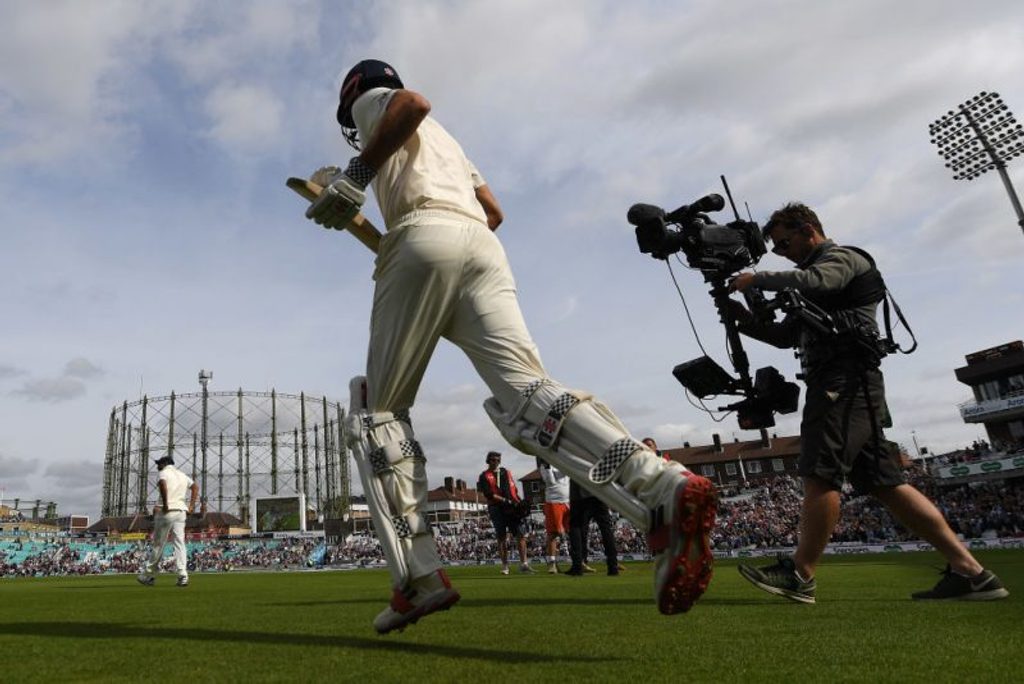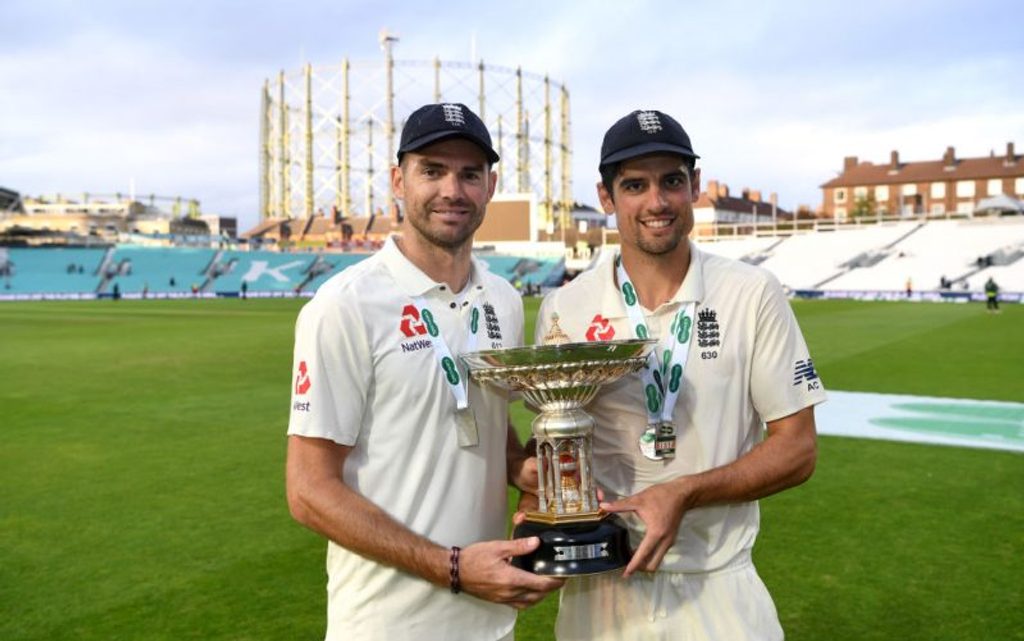
In the 2019 Wisden Cricketers’ Almanack, Scyld Berry paid tribute to Alastair Cook and recalled his incredible goodbye to international cricket.
Scyld Berry is the cricket correspondent of The Daily Telegraph
The 2019 Wisden Cricketers’ Almanack is available to buy here. The most famous sports book in the world has been published every year since 1864.
Parting is such sweet sorrow, according to the Bard in Romeo and Juliet. In professional cricket, however, it is almost invariably plain sorrow: bitterness at the thought of what might have been, resentment at what was not, and even rage against the dying of the light. So Alastair Cook’s farewell to the international game, in being the sweetest there could be, defied all precedent.
Nobody at Joe Root’s press conference at The Oval, the day before the Fifth Test against India, had really believed him when he said a Cook century might be “written in the stars”. Most cricketers’ final Tests, when announced in advance, have been a disappointment. The nervous energy required to reach peak performance has drained away; even 99 per cent is not enough in Test cricket. Farewells at The Oval, in particular, have been more sorrow than joy. England’s oldest Test ground had never seen a departure, by any cricketer from any country, to match the grandeur of the setting: no one has made a major contribution while seeing his side to victory in both match and series.
 Cook celebrates reaching his final Test century
Cook celebrates reaching his final Test century
Jack Hobbs had started the tradition in 1930, on his home ground, when the Australians – led by Bill Woodfull – gave him three cheers as he walked out to bat, and Hobbs had replied: “Thank you very much, you chaps.” He did not, however, shake Woodfull’s hand: modest Jack thought it would be showing off to the crowd, and he lived to regret it. The protocol was thus in place for Don Bradman’s last Test, 18 years later. The sole survivor of Hobbs’s last, Bradman knew the form, as did Norman Yardley, who led England in giving him three cheers – and two balls at the wicket. Hobbs scored 47 and nine, Bradman nought.
In more recent Oval farewells, Viv Richards was carried off the field in 1991 by his players, his proud record of never captaining West Indies in a losing Test series intact – but England had won the game. Curtly Ambrose was warmly saluted in 2000, though West Indies were already steep in decline. The following summer, Michael Atherton scored 13 and nine, before being Warned and McGrathed one final time. Andrew Flintoff ran out Ricky Ponting with his famous final fling in 2009, but apart from that it was only a few runs and one wicket. Cook had been struggling too. He had gone into a downward spiral, apart from his marathon double-centuries at Edgbaston against West Indies the previous summer and at Melbourne the previous winter.
The two-Test series in New Zealand early in 2018 had not been environmentally friendly: 23 runs, one for every 1,000 miles travelled. Technically, Cook looked all right, better than ever at times, because his warm-up routines now began with underarm throws from ten yards, which got his front foot moving, and he drove through mid-off as never before. But after an hour or two he would play a big shot and get out, as if he had lost concentration, one of his greatest virtues.
Less than a week after The Oval, I chaired a Q&A session with Moeen Ali, who had been promoted to No. 3 and shared a long stand with Cook that wore India down on the first day. “The thing was, he didn’t want to make nought in either innings,” said Moeen. No, you would not want to go the same way as Bradman. Then he illuminated Cook’s struggles since Root had taken over, the difference in styles, and the tension – not personal but strategic. “The difference between the two captains is: Rooty is all about ‘Let’s go out there and put pressure on them,’ not carefree or anything, but it’s all about scoring runs. Cooky was all about earning the right: fight for runs, grind them down, build partnerships and get the bowlers tired – almost the opposite.”
Hence, perhaps, Cook’s drive in the fourth Test at Southampton, where he had done an hour and a half’s hard work. Had he still been captain, he would have soldiered on, nudging off his hip and cutting anything short – although those days had almost vanished, as bowlers had wised up, aiming full, often from round the wicket. But, in loyalty to the new team directive, he threw his bat and was gone.
 “In the final innings of his 161st Test, Cook again went to the well, and on this occasion it was not dry”
“In the final innings of his 161st Test, Cook again went to the well, and on this occasion it was not dry”
Cook’s mentor, Graham Gooch, had in his last year of Test cricket batted as well as ever to reach 20 or 30, but could not carry on. Why expect anything different from his pupil? His scores against India before the fifth Test had been 13, 0, 21, 29, 17, 17 and 12. But in the first innings at The Oval, Cook reached 71, very acceptable given how much India’s pace bowlers had hooped the new and old balls around all series: it was the first fifty by an opening batsman on either side. Point made: he could still do it, and his reflexes were still working, which was reinforced by his catching, safer than any of his team-mates in the cordon. Second slips came and went, from Dawid Malan to Jos Buttler and back to Root, all shelling half the chances that came their way.
In the final innings of his 161st Test, Cook again went to the well, and on this occasion it was not dry. But even though he reached 46 by the close on the third evening, surely the stars were not aligned? Ishant Sharma, who had tormented him as much as anyone in Test cricket, and dismissed him three times in the series alone, damaged his left ankle in the first over next morning. India were left with two quicks and a spinner. The pitch flattened out, and batting became easier than at any time in the summer.
Cook played, and middled, all his shots. And no century has ever been made without good fortune: he reached 97 with a jab towards deep point, where a tired Jasprit Bumrah took aim at the non-striker’s stumps and missed by such a margin that the ball went for four overthrows. Three minutes of unadulterated applause and appreciation ensued. Then more fine strokes in his 147, such as his cover drive, if not a six (there were only 11 in his whole Test career). It is futile to compare Cook with W. G. Grace or Hobbs or Len Hutton. Hobbs, after the First World War, enjoyed the highest-scoring era of Test cricket. Hutton, after the Second, faced another new ball after 55 overs.
The pertinent point is that England have had two types of opening batsman. There was the attacker, such as Hobbs, or the pre-war Hutton before he injured his left arm, or Gooch against West Indies when they were world champions. And there was the defender, the accumulator, who did not try to dominate the bowling – most notably Geoffrey Boycott and Cook. A nice symmetry was observed: Cook made a fifty and a hundred in both his first Test and his last. But, truth be told, his six-hour hundred on debut at Nagpur delayed England’s declaration, so that there was no time for a second new ball, and India held on with four wickets left.
His 33rd century, by contrast, gave England exactly what they wanted: almost four sessions to bowl India out on a more sporting pitch. Andrew Strauss called Cook the greatest of all England cricketers, because of the qualities required to play 161 Tests, all bar two in a row. His loyalty towards a former opening partner was admirable. But objectivity will not accept such a judgement. To cite just three players more worthy of the accolade: Grace made cricket what it is today, the first mass spectator sport; Hobbs scored 12 Test centuries against Australia, the acid test through the ages; and Ian Botham regularly overwhelmed them.
What can be said unequivocally was that Cook was a model Test cricketer. His last two years in the England side came at a time when mendacity has never had it so good in public life, whether in the Brexit debate, or in Donald Trump’s tweets. Decency, good manners, straightforwardness (honesty is sometimes impossible if you are a Test captain and asked if one of your players is going to be dropped): when politicians and other public figures seemed to have forgotten their worth, Cook preserved these anachronisms.
He did it without confrontation. Like Strauss, whom he had long observed, Cook would not get into an argument. He preferred to win a long-term battle rather than a short-term row. He read the newspapers, taking note and using the criticisms as motivation to prove people wrong, by which he meant commentators and journalists. In the end he won, most handsomely, by going out on his own terms, on the highest of highs. As a captain, too, Cook could not have been more decent, towards his own men or opponents or umpires. I never saw him confront anyone on the field. If a bowler was ineffectual, he put him out to grass, as if back on his farm. If an opponent tried sledging, he walked away, head held high. If an umpire made an unpalatable decision against England’s bowlers, Cook showed him respect in their conversation before resuming the game.
He suffered the slings and arrows in defeat, and never gloated when England won. He inherited the safe style of Strauss, focusing on man-management and the conservation of runs as the chief strategy, without much interest in tactics, though in the second half of his reign he was ready to try funkier fields. His forte as captain? Defending a target with outward calm, most notably against Australia at Trent Bridge in 2013, when he drew the best out of James Anderson, and led England home by 14 runs.
Cook’s values – old-fashioned duty and service first, never mind the ego – were exemplified until the end. When he reached his hundred, he did not milk the applause: eventually he tried to signal to the crowd that the match should carry on. When he got out, top-edging his cut at an off-break, he walked off with a couple of turnarounds to acknowledge the spectators – not too much, not too little. And when Anderson sought his 564th Test wicket on the last day, to go past Glenn McGrath’s record for the most by a pace bowler, Cook subsumed his desire to be the man who took the catch. They had, after all, taken more Test wickets than any other English pair of fielder and bowler.
 England’s leading wicket-taker alongside England’s highest Test run-scorer
England’s leading wicket-taker alongside England’s highest Test run-scorer
Though they were the best of team-mates, Cook said it was the right outcome when Anderson flattened the middle stump of Mohammed Shami, because that image would live longer in the memory. Cook’s farewell was superlative – to match his feat of being England’s highest Test run-scorer, leading century-maker, longest-serving captain, and most prolific slip catcher – because it was the most joyous farewell of any English cricketer. The one to beat was another Essex and England captain, not his batting mentor, Gooch, but his mentor on media matters, Nasser Hussain. After scoring an unbeaten 103 at Lord’s in 2004 against New Zealand, Hussain had run off the field and finalised his decision to retire, with the applause still in his ears – and before the selectors could drop him.
A batsman had to go for the next Test, because Strauss on debut had made himself undroppable, and Hussain, as the oldest, was the most vulnerable. So he got his retirement in first. But Cook retired in his own time, at the right time. Was it all self-indulgent? No. If the series had stood at 2–2 after Southampton, he would not have rocked the boat by announcing the Oval Test would be his last: that would have distracted the team from their task of beating the world’s No. 1 side. Instead, at 3–1, it was only right for once that the individual should be as big as the team.
It has to be added that Cook’s handsomeness – of face and physique, that is, not his batting – added to the poignancy that many onlookers felt as he climbed the pavilion steps for the final time. Not every eye at The Oval was dry.








